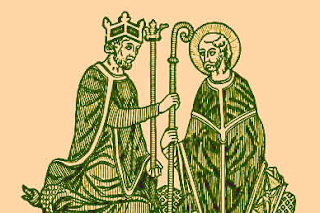Question of Investiture
At the end of XI century, the papacy sought to eliminate the interference of the temporal power of the Church and at the same time establish its own supremacy over the Christian rulers. The culmination of this clash between Church and State had the initial protagonists Pope Gregory VII and Emperor Henry IV of the Holy Roman Empire.
This clash of huge importance in the Middle Ages , known as Question of Investiture orQuarrel of Investiture . The latter, however, is a misnomer, since the word quarrel - argument or fight minor - does not reflect the seriousness of the clash between two powers that and wanted universal.
In Germany, the imperial authority rested primarily on ecclesiastical lords - archbishops, bishops and abbots - since the lay lords showed a strong localist trend. Taking advantage of his hitherto undeniable supremacy, the emperors had been investing the German bishops in their roles (lay investiture), which weakened the subordination of the high clergy and the pope favored the practice of simony and Nicolaitanism.
Influenced by reformists and moralizing ideas La Order of Cluny, the Papacy sought to free himself from his submission to the empire, taking the emperors the prerogative to appoint the pope and to invest the German bishops.His first successful step was the creation of the College of Cardinals (or Sacred College), whose main function would be to elect the pontiff.
Gregory VII, elected in 1073, began the fight against the emperor, forbidding him to grant the lay investiture. Henry IV continued that practice and was excommunicated - which meant automatic breaking of vassalage ties that bound the Germans masters the emperor.
The king begged forgiveness from the pope, humbling themselves before the pope in Canossa, a castle located in northern Italy. The pope forgave him and Henry returned to Germany with his authority restored. Then the German sovereign attacked Rome at the head of an army, forcing Gregory VII to flee, accompanied by prelates (bishops) reform.Taking advantage of the exile of the Pope, Henry enthroned in Rome a German bishop, who assumed the papal throne with the name of Clement III. But the other Christian rulers refused to recognize it, remaining faithful to Gregory VII and his legitimate successors.
During the Question of Investiture, both Henry IV and his son and successor, Henry V, tried more than once to impose popes in Rome of your choice. This situation only came to an end with the Concordat of Worms (1122), in which Henry V renounced his claim to perform the lay investiture in Germany.
The retreat of the emperor marked the beginning of papal supremacy over temporal power - supremacy that would remain for nearly two centuries. The Crusades, which began to be organized by then, would the pope's authority even greater projection.
The power of the Church of the faithful was incontestable. Sinners had to fulfill penances, which ranged from prayers and fasts to pilgrimages and participation in the Crusades.The excommunication (expulsion of the Christian community) was the most feared punishment. It applied the ban (prohibition of holding religious services) to the areas of the rulers who were in dispute with the Church.
The heresies were suppressed with violence, as happened with the Vaudois and theAlbigenses in the thirteenth century. The Albigensian, located in southern France, were exterminated by a "crusade" of French North lords, headed by Count Simon de Montfort, at the request of Pope Innocent III.
Please Share
Category: General history













0 komentar